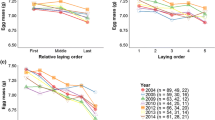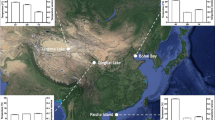Abstract
Adaptive within-clutch allocation of resources by laying females is an important focus of evolutionary studies. However, the critical assumption of these studies, namely that within-clutch egg-size deviations affect offspring performance, has been properly tested only rarely. In this study, we investigated effects of within-clutch deviations in egg size on nestling survival, weight, fledgling condition, structural size and offspring recruitment to the breeding population in the collared flycatcher (Ficedula albicollis). Besides egg-size effects, we also followed effects of hatching asynchrony, laying sequence, offspring sex and paternity. There was no influence of egg size on nestling survival, tarsus length, condition or recruitment. Initially significant effect on nestling mass disappeared as nestlings approached fledging. Thus, there seems to be limited potential for a laying female to exploit within-clutch egg-size variation adaptively in the collared flycatcher, which agrees with the majority of earlier studies on other bird species. Instead, we suggest that within-clutch egg-size variation originates from the effects of proximate constraints on laying females. If true, adaptive explanations for within-clutch patterns in egg size should be invoked with caution.




Similar content being viewed by others
References
Amat JA, Fraga RM, Arroyo GM (2001) Intraclutch egg-size variation and offspring survival in the kentish plover Charadrius alexandrinus. Ibis 143:17–23
Anderson DJ, Reeve J, Bird DM (1997) Sexually dimorphic eggs, nestling growth and sibling competition in american kestrels Falco sparverius. Funct Ecol 11:331–335
Becker PH, Wink M (2003) Influences of sex, sex composition of brood and hatching order on mass growth in common terns Sterna hirundo. Behav Ecol Sociobiol 54:136–146
Bize P, Roulin A, Richner H (2002) Covariation between egg size and rearing condition determines offspring quality: an experiment with the alpine swift. Oecologia 132:231–234
Blanco G, Martínez-Padilla J, Serrano D, Dávila JA, Viñuela J (2003) Mass provisioning to different-sex eggs within the laying sequence: consequences for adjustment of reproductive effort in a sexually dimorphic bird. J Anim Ecol 72:831
Budden AE, Wright J (2001) Begging in nestling birds. In: Nolan V, Thompson CF (eds) Current ornithology. Kluwer, New York, pp 83–118
Burnham KP, Anderson DR (1998) Model selection and inference: a practical information-theoretic approach. Springer, Berlin Heidelberg New York
Chaterjee S, Hadi AS, Price B (2000) Regression analysis by example. Wiley, New York
Christians JK (2002) Avian egg size: variation within species and inflexibility within individuals. Biol Rev 77:1–26
Cichoń M (1997) Egg weight variation in collared flycatchers Ficedula albicollis. Ornis Fenn 74:141–147
Cichoń M, Dubiec A, Stoczko M (2003) Laying order and offspring sex in blue tits Parus caeruleus. J Avian Biol 34:355–359
Cohen J (1988) Statistical power analysis for behavioral sciences. Erlbaum, N.J.
Colegrave N (2001) Differential allocation and “good genes”—comment from Colegrave. Trends Ecol Evol 16:22–23
Cordero PJ, Griffith SC, Aparicio JM, Parkin DT (2000) Sexual dimorphism in house sparrow eggs. Behav Ecol Sociobiol 48:353–357
Cordero PJ, Viñuela J, Aparicio JM, Veiga JP (2001) Seasonal variation in sex ratio and sexual egg dimorphism favouring daughters in first clutches of the spotless starling. J Evol Biol 14:829–834
Cramp S, Perrins CM (1993) The birds of the western Palearctic. Oxford University Press, Oxford
Cunningham EJA, Russell AF (2000) Egg investment is influenced by male attractiveness in the mallard. Nature 404:74–77
Dawson RD, Clark RG (1996) Effects of variation in egg size and hatching date on survival of lesser scaup Aythya affinis ducklings. Ibis 138:693–699
Erikstad KE, Tveraa T, Bustnes JO (1998) Significance of intraclutch egg-size variation in common eider: the role of egg size and quality of ducklings. J Avian Biol 29:3–9
Freckleton RP (2002) On the misuse of residuals in ecology: regression of residuals vs. multiple regression. J Anim Ecol 71:542–545
Gebhardt-Henrich SG, Richner H (1998) Causes of growth variation and its consequences for fitness. In: Starck JM, Ricklefs RE (eds) Avian growth and development: evolution within the altricial-precocial spectrum. Oxford University Press, Oxford, pp 324–339
Gil D, Graves J, Hazon N, Wells A (1999) Male attractiveness and differential testosterone investment in zebra finch eggs. Science 286:126–128
Graham MH (2003) Confronting multicollinearity in ecological multiple regression. Ecology 84:2809–2815
Grant MC (1991) Relationship between egg size, chick size at hatching and chick survival in the whimbrel Numenius phaeopus. Ibis 133:127–133
Griffith SC, Owens IPF, Thuman KA (2002) Extra pair paternity in birds: a review of interspecific variation and adaptive function. Mol Ecol 11:2195–2212
Griffiths R, Double MC, Orr K, Dawson RJG (1998) A DNA test to sex most birds. Mol Ecol 7:1071–1075
Hillström L (1999) Variation in egg mass in the pied flycatcher, Ficedula hypoleuca: an experimental test of the brood survival and brood reduction hypotheses. Evol Ecol Res 1:753–768
Hoenig JM, Heisey DM (2001) The abuse of power: the pervasive fallacy of power calculations for data analysis. Am Stat 55:19–24
Howe HF (1976) Egg size, hatching asynchrony, sex and brood reduction in the common grackle. Ecology 57:1195–1207
Hoyt DF (1979) Practical methods of estimating volume and fresh weight of birds’ eggs. Auk 96:73–77
Järvinen A, Ylimaunu J (1986) Intraclucth egg-size variation in birds: physiological responses of individuals to fluctuations in environmental conditions. Auk 103:235–237
Kozielska M, Krzemińska A, Radwan J (2004) Good genes and the maternal effects of polyandry on offspring reproductive success in the bulb mite. Proc R Soc Lond B 271:165–170
Krist M, Remeš V (2004) Maternal effects and offspring performance: in search of the best method. Oikos (in press)
Kruuk LEB, Merilä J, Sheldon BC (2001) Phenotypic selection on a heritable size trait revisited. Am Nat 158:557–571
Leblanc Y (1987a) Relationships between sex of gosling and position in the laying sequence, egg mass, hatchling size and fledgling size. Auk 104:73–76
Leblanc Y (1987b) Egg mass, position in the laying sequence and brood size in relation to canada goose reproductive success. Wilson Bull 99:663–672
Lipar JL (2001) Yolk steroids and the development of the hatching muscle in nestling european starlings. J Avian Biol 32:231–238
Magrath RD (1990) Hatching asynchrony in altricial birds. Biol Rev 65:587–622
Magrath RD (1992) Roles of egg mass and incubation pattern in establishment of hatching hierarchies in the blackbird (Turdus merula). Auk 109:474–487
Magrath MJL, Brouwer L, Komdeur J (2003) Egg size and laying order in relation to offspring sex in the extreme sexually size dimorphic brown songlark, Cinclorhamphus cruralis. Behav Ecol Sociobiol 54:240–248
Mead PS, Morton ML (1985) Hatching asynchrony in the mountain white-crowned sparrow (Zonotrichia leucophrys oriantha): a selected or incidental trait? Auk 102:781–792
Mead PS, Morton ML, Fish BE (1987) Sexual dimorphism in egg size and implications regarding facultative manipulation of sex in mountain white-crowned sparrows. Condor 89:798–803
Meijer T, Drent R (1999) Re-examination of the capital and income dichotomy in breeding birds. Ibis 141:399–414
Merilä J, Kruuk LB, Sheldon BC (2001) Cryptic evolution in a wild bird population. Nature 412:76–79
Nilsson JA, Svensson E (1993) Causes and consequences of egg mass variation between and within blue tit clutches. J Zool 230:469–481
O’Connor RJ (1979) Egg weights and brood reduction in the european swift (Apus apus). Condor 81:133–145
Ojanen M, Orell M, Väisänen A (1981) Egg size variation within passerine clutches: effects of ambient temperature and laying sequence. Ornis Fenn 58:93–108
Parker TH (2003) Genetic benefits of mate choice separated from differential maternal investment in red junglefowl (Gallus gallus). Evolution 57:2157–2165
Parsons J (1976) Factors determining the number and size of eggs laid by the herring gull. Condor 78:481–492
Pärt T (1990) Natal dispersal in the collared flycatcher: possible causes and reproductive consequences. Ornis Scand 21:83–88
Pelayo JT, Clark RG (2003) Consequences of egg size for offspring survival: a cross-fostering experiment in ruddy ducks (Oxyura jamaicensis). Auk 120:384–393
Perrins CM (1970) The timing of birds’ breeding seasons. Ibis 112:242–255
Pierotti R, Bellrose CA (1986) Proximate and ultimate causation of egg size and the third-chick disadvantage in the western gull. Auk 103:401–407
Rutkowska J, Cichoń M (2002) Maternal investment during egg laying and offspring sex: an experimental study of zebra finches. Anim Behav 64:817–822
Saino N, Bertacche V, Ferrari RP, Martinelli R, Møller AP, Stradi R (2002a) Carotenoid concentration in barn swallow eggs is influenced by laying order, maternal infection and paternal ornamentation. Proc R Soc Lond B 269:1729–1733
Saino N, Ferrari RP, Martinelli R, Romano M, Rubolini D, Møller AP (2002b) Early maternal effects mediated by immunity depend on sexual ornamentation of the male partner. Proc R Soc Lond B 269:1005–1009
SAS Institute (2000) SAS online document, version 8. SAS Institute, Cary, N.C
Schwabl H (1993) Yolk is a source of maternal testosterone for developing birds. Proc Natl Acad Sci USA 90:11446–11450
Schwabl H (1996) Maternal testosterone in the avian egg enhances postnatal growth. Comp Biochem Physiol A 114:271–276
Seutin G, White BN, Boag PT (1991) Preservation of avian blood and tissue samples for DNA analyses. Can J Zool 69:82–90
Sheldon BC (2000) Differential allocation: tests, mechanisms and implications. Trends Ecol Evol 15:397–402
Sheldon BC, Ellegren H (1996) Offspring sex and paternity in the collared flycatcher. Proc R Soc Lond B 263:1017–1021
Sheldon BC, Merilä J, Qvarnström A, Gustafsson L, Ellegren H (1997) Paternal genetic contribution to offspring condition predicted by size of male secondary sexual character. Proc R Soc Lond B 264:297–302
Singer JD (1998) Using SAS PROC MIXED to fit multilevel models, hierarchical models, and individual growth models. J Educat Behav Stat 24:323–355
Slagsvold T, Lifjeld JT (1989) Constraints on hatching asynchrony and egg size in pied flycatchers. J Anim Ecol 58:837–849
Slagsvold T, Sandvik J, Rofstad G, Lorentsen O, Husby M (1984) On the adaptive value of intraclutch egg-size variation in birds. Auk 101:685–697
Steidl RJ, Hayes JP, Schauber E (1997) Statistical power analysis in wildlife research. J Wildl Manage 61:270–279
Teather KL (1989) Sex and egg size in great-tailed grackles. Condor 91:203–205
Trivers RL, Willard DE (1973) Natural selection of parental ability to vary the sex ratio of offspring. Science 179:90–92
Viñuela J (1996) Establishment of mass hierarchies in broods of the black kite. Condor 98:93–99
Viñuela J (1997) Adaptation vs. constraint: intraclutch egg-mass variation in birds. J Anim Ecol 66:781–792
Weatherhead PJ (1985) Sex-ratios of red-winged blackbirds by egg size and laying sequence. Auk 102:298–304
Whittingham LA, Schwabl H (2002) Maternal testosterone in tree swallow eggs varies with female aggression. Anim Behav 63:63–67
Wiggins DA (1990) Sources of variation in egg mass of tree swallows Tachycineta bicolor. Ornis Scand 21:157–160
Williams TD, Lank DB, Cooke F (1993a) Is intraclutch egg-size variation adaptive in the lesser snow goose? Oikos 67:250–256
Williams TD, Lank DB, Cooke F, Rockwell RF (1993b) Fitness consequences of egg-size variation in the lesser snow goose. Oecologia 96:331–338
Ylimaunu J, Järvinen A (1987) Do pied flycatchers Ficedula hypoleuca have brood-survival or brood-reduction strategy? Ornis Fenn 64:10–15
Acknowledgements
We thank E. Tkadlec, K. Weidinger and several anonymous referees for valuable comments on or discussion of the manuscript, and J. Stříteský for exceptional field co-operation. K. Weidinger kindly provided us with plastic eggs. We thank forest enterprise Čechy pod Kosířem for providing the nest-boxes and caravan needed for this work. M. K. thanks Kačenka for everyday support. This study was supported by a grant from the Czech Ministry of Education (MSM 153100012) and from GAČR (no. 206/03/0215). The study was approved and supervised by the Ethical Committee of Palacký University and complies with the current law of the Czech Republic.
Author information
Authors and Affiliations
Corresponding author
Rights and permissions
About this article
Cite this article
Krist, M., Remeš, V., Uvírová, L. et al. Egg size and offspring performance in the collared flycatcher (Ficedula albicollis): a within-clutch approach. Oecologia 140, 52–60 (2004). https://doi.org/10.1007/s00442-004-1568-5
Received:
Accepted:
Published:
Issue Date:
DOI: https://doi.org/10.1007/s00442-004-1568-5




